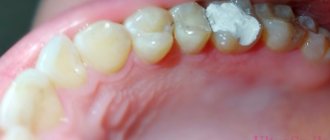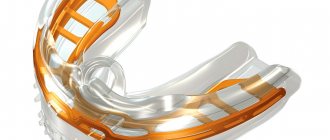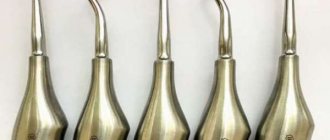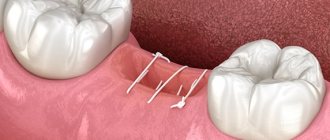Indications for placing a temporary filling
- Treatment of deep caries. After cleansing the tooth cavity from necrotic masses, the dentist places a medicinal solution that helps the dentin strengthen the layer between the pulp chamber and the open cavity.
- Diagnosis of the condition of the tooth with deep caries before installing a permanent filling.
- Acute pulpitis. A temporary intermediate composition is placed while the nerve is removed.
- Periodontitis. To relieve inflammation, an antiseptic or medicinal preparation is placed in the area of the tooth roots, which is then covered with light cement.
- Sanitation of dental canals before filling. The doctor cleans the canals, filling them with a disinfectant solution, then places a temporary filling.
- Prosthetics, restoration. The process of making an artificial crown or orthodontic structure takes several days. To protect against microbes, the open tooth cavity is closed with a temporary filling material.
Stages of placing a temporary filling:
- opening the tooth cavity, removing all affected dentin tissue;
- expansion, cleaning, treatment of dental canals;
- therapeutic stage (depending on the diagnosis, the nerve endings of the pulp are removed, medications are placed in the tooth cavity, and the canals are filled with temporary cement);
- The crown is closed with a temporary filling.
Types of temporary fillings by composition
A temporary filling, like a permanent one, can be made from several materials:
- water dentin – usually used in the treatment of baby teeth;
- dentine paste - more often used for localization of drugs and has antiseptic properties, but completely hardens in 2-3 hours;
- cements - usually used when working with teeth that experience heavy physical stress;
- polymers - they are elastic, have good adhesion to the walls of the tooth and are more often used in dental restoration and for attaching temporary inlays;
Your doctor may offer you a choice of several materials for making a filling. Of course, he himself will explain all the nuances and offer the best option, but remember that the cost of the service always depends on this. Also, the composition of the filling is directly related to how long it will have to be worn before replacement.
Material of manufacture
Requirements for temporary filling materials:
- no toxic effect on tooth structures (enamel, dentin, pulp) and mucous membranes of the oral cavity;
- safety for human health;
- chemical inertness and high resistance to saliva and aggressive environments (alkalies, acids);
- mechanical strength, wear resistance, ductility;
- lack of galvanization effect;
- maintaining shape and size during hardening;
- good radiopacity.
The choice of material for a temporary filling depends on the clinical case, age, individual characteristics of the body (the presence of allergies to certain substances), as well as how long the patient will wear it.
What is the difference between a temporary filling and a permanent one?
The obvious main difference is the length of time the filling is used. If a permanent filling is placed, on average, for 5 years, then a temporary filling is placed for a period strictly determined by the doctor. It can be several days or a couple of months.
This leads to the following difference between permanent and temporary fillings - they do not need such durability. Temporary options are made from less durable materials, because they will not have to experience heavy loads for a long time.
It is logical to assume that permanent fillings are more expensive. This is true. They are made from more expensive materials, so the price for such fillings will be higher.
If the doctor necessarily offers the client a choice of material for a permanent filling, then with a temporary filling it is not so simple - sometimes the dentist will voice his choice or several proposals, but more often he makes the choice himself, without consulting the patient.
Intermediate filling materials
- A paste based on zinc sulfate and kaolin allows you to restore the crown of the tooth.
- Karyosan has an analgesic and antiseptic effect.
- Vinoxol is an artificial dentin. Withstands chewing load for up to 1-2 months.
- Cement with zinc and eugenol. It is used for antiseptic treatment of tooth tissue and relief of the inflammatory process.
- Glass ionomer cement is used for temporary fixation of the prosthesis.
- One-component polymer materials are pastes with a viscous consistency that harden under the light of a special lamp.
Permanent filling material
The materials used to make dental fillings for permanent use vary. Many of those that dentists previously used for fillings have fallen out of use. Metal alloys have ceased to be used due to their increased thermal conductivity and the ability to lead to overheating of the pulp. Gone are also some types of plastics that turned out to be toxic or not durable enough. Dentists refused cementation, since this method poorly reproduced the density and color of natural teeth, in addition, cement required serious grinding of entire tooth tissues.
Today, teeth are filled with composite materials, which are divided into chemical and light. Hardening of a chemical filling occurs due to a corresponding chemical reaction, and a light filling hardens when illuminated with blue light emitted by a special lamp.
How long does it take to wear a temporary filling?
Depending on the material of manufacture, a temporary filling has different characteristics of strength and tightness and can last from several days to six months.
Average duration of use of a temporary filling:
- 2-3 days, if a drug is placed under the filling that destroys the nerve endings of the pulp;
- 7–10 days while treatment of the inflammatory process with periodontitis or pulpitis continues;
- 2-3 weeks - for the period of manufacture of the orthopedic structure;
- several months in special diagnostic cases (when treating a dental cyst, restoring dentin after deep caries).
It is necessary to strictly adhere to the timing of wearing temporary fillings. If the time period is extended, its integrity and sealing may be compromised, which will negatively affect the health of the tooth. Thus, arsenic-based paste, if not removed after 2-3 days, begins to penetrate the dentin through the tubules, destroying bone tissue.
How long a temporary filling can be worn is decided by the attending physician, depending on the diagnosis and the chosen treatment method.
Removing a temporary filling is a mandatory procedure before placing a permanent filling. After removal of the temporary composite, antiseptic treatment of the root canals and dental cavity is carried out. Next, a permanent filling is installed.
Filling care
There is no need to take special care of fillings, at least no more than the teeth themselves. Teeth with and without fillings should be brushed regularly, at least twice a day, thoroughly removing plaque and food debris. It is worth visiting the dentist approximately every six months for preventative oral hygiene. During this procedure, existing fillings will be polished and carefully inspected.
Do not forget that the material for filling teeth is more porous than tooth enamel, so the filling can change its color under the influence of coloring drinks or foods. For the first time after caries treatment, you should not eat red berries, beets and other foods, especially if your front teeth are filled.
Problems that arise when installing a temporary filling
Painful sensations can be caused by an incompletely destroyed nerve, infection under the filling, or the development of inflammation.
The filling falls out or crumbles. If you do not immediately consult a dentist, the treatment will have to begin again with re-sanitation of the canals, treating them with antiseptics to stop the development of infection.
An unpleasant taste in the mouth often indicates depressurization of the temporary coating, when the medicine from the tooth begins to leak into the oral cavity.
Darkening of the filling, swelling or redness of the gums may be signs of an allergic reaction to a component of the filling material.
Possible complications after tooth filling
Most often, patients complain that the filled tooth continues to hurt under the installed filling. If we are talking about the first hours after filling (maximum - up to a day), this can be considered normal. If the tooth continues to hurt for the second day, this may be a sign of a medical error, for example, poor quality of treatment of a carious cavity before placing filling material in it. In this case, you need to go to the dental clinic, get examined, and take an x-ray. Treatment may need to be repeated.
Another common reason for visiting a doctor is a filling that has fallen out. If this happens after several years, it is possible that the filling has simply expired and needs to be replaced. A filling that is not replaced in time can actually fall out. The doctor will determine the reason - either the warranty period has expired and the tooth was not treated in a timely manner, or new caries has formed. If a fresh, recently placed filling falls out, we can confidently speak of a medical error.
What problems may arise that will shorten the wearing period?
Lost temporary filling
After installing a temporary filling, the following problems may occur:
- pain associated with infection of the cavity or incompletely killed pulp;
- crumbling and loss of filling material;
- the presence in the mouth of a sharp specific smell that even interrupts the taste of food;
- formation of dark spots on the tooth;
- swelling of the gums, often accompanied by a stench.
If you have one of the listed symptoms (for example, if a filling has fallen out and the tooth hurts), you should immediately consult your doctor. The consequences of deformation of the filling or undetected problems with the tooth can provoke complications and, as a result, additional costs for treatment.
To prevent deformation and loss of the filling material, it is recommended to exclude rough and solid foods from the diet while wearing the temporary filling, and also clean the oral cavity twice a day with toothpaste and a brush.
Types of fillings
Permanent fillings
The ideal filling material has not yet been invented that would meet all of the above requirements without exception; development and research in this direction are still underway. Existing materials for permanent fillings are varied:
- Cements are two-component systems consisting of powder and liquid. The components are mixed before use, and the mass hardens as a result of a chemical reaction between the components.
- Mineral cements: Zinc phosphate – consist of zinc oxide and phosphoric acid. The advantages of this material: low toxicity, good thermal insulation properties, compliance with the KTR of the filling KTR of tooth tissue. Disadvantages: shrinkage during seal operation, low chemical resistance.
- Silicophosphate - a mixture of zinc oxide, aluminosilicate glass and phosphoric acid. They have good plasticity and adhesion, have almost no toxic effect on tooth tissue, and have sufficient hardness. Disadvantage: strong difference from the enamel color. They also need to install an insulating gasket before filling.
- Silicate - they contain aluminosilicate glass and phosphoric acid. Fillings made of silicate cement do not withstand chewing loads well and have a toxic effect on the pulp. For the treatment of caries, they are used only with an insulating pad. Refers to obsolete type of materials.
- Polymer cements:
- Polycarboxylate - consist of zinc oxide and polyacrylic acid. They have good adhesion to the tooth and high biocompatibility with tissues. Ideal for treating temporary teeth and preparing teeth for crowns.
- Glass ionomer - formed by mixing aluminosilicate glass and a solution of polyacrylic acid. They have many advantages: they form a chemical bond with hard dental tissues, do not irritate the pulp, are radiopaque, release fluorides into the tissue after hardening, are resistant to saliva and food, are adapted to the color of enamel, and have the same coefficient of thermal expansion as dentin. The disadvantages of glass ionomer cements include low wear resistance and strength, difficulties in processing and polishing fillings.
- Plastics:
- Unfilled - made on the basis of acrylic and epoxy resins. Due to such negative properties as shrinkage after polymerization, the irritating effect of components on the pulp, and the large difference in the coefficient of thermal expansion with the CTE of hard dental tissues, these materials are now almost never used.
- Filled (composite) – complex compounds of organic polymer resins and inorganic fillers. As a result of this combination, the filling material acquires improved properties. Chemically cured composites - hardening of the filling occurs as a result of a polymerization reaction that occurs between the components of the filling material after they are mixed. Disadvantage: darkening of the filling over time and limited time for working with the material.
- Light-curing composites - the filling hardens under the influence of a halogen lamp. This filling material is the most commonly used filling material, it is suitable for aesthetic restorations, has good adhesion and a long service life.
Filled composites are classified by the size of the filler particles (macro-, micro-, mini-filled and hybrid), by consistency (regular, liquid, condensed), by purpose (for chewing, anterior teeth, universal).
- Metal materials:
- Silver amalgam is an alloy of silver (66%), tin, copper and zinc, which is mixed with mercury. Among the positive properties of this material are strength, resistance to saliva, and low cost. Disadvantages of silver amalgams: lack of adhesion to tooth tissue, irritation of the pulp due to high thermal conductivity, toxicity of mercury vapor for medical staff, metallic color of the filling. In Russia, such fillings are no longer installed.
- Pure gold - suitable for placing small fillings, requires the dentist to have certain skills and special tools.
- Compomers are composite ionomer compositions. They combine the positive properties of composites and glass ionomers. However, the strength and wear resistance of compomers is slightly lower than that of composites; The material is inferior to glass ionomers in terms of adhesion to tooth tissue and the amount of fluoride released. Compomer fillings are placed if they do not require high aesthetics and do not experience significant chewing loads.
Temporary fillings
The purpose of this type of filling is to temporarily close treated cavities for the purpose of further diagnosis and treatment. Fillings are placed for a limited period: from one day to a year, depending on what the doctor’s goal is.
Requirements for temporary fillings:
- Sufficient strength to provide cavity protection until a permanent filling is placed.
- Easy and complete removal without boron.
- No influence on adhesion and curing of permanent fillings.
- Safety for the patient in case of accidental ingestion.
Purpose of temporary filling materials:
- application of insulating pads;
- filling of baby teeth;
- placement of control fillings in the treatment of deep caries and pulpitis;
- temporary fixation of orthopedic structures.
Classification of temporary fillings depending on the chemical composition:
- Zinc-eugenol cements are a mixture of zinc oxide and eugenol. Eugenol is a substance of the phenolic class, the main component of clove and eugenolic basil essential oils. It is a colorless liquid with a clove odor; has analgesic and antiseptic effects. Fillings of this type completely harden 6-8 hours after installation.
- Dentin paste - consists of a mixture of artificial dentin and vegetable oils (usually peach and clove). Hardens in the mouth within two hours. The advantages of the material include its antiseptic effect, the absence of a mixing stage (the paste is produced in finished form), and strength. The disadvantage of dentin paste, as well as other cements containing eugenol, is long-term hardening, which precludes its use when applying arsenic paste to a carious cavity (the toxic substance seeps through the filling into the oral cavity). Eugenol also impairs the adhesion of permanent fillings.
- Eugenol-free cements: Zinc sulfate (artificial dentin) - a mixture of zinc sulfate, zinc oxide and white clay. After dilution with water, it hardens within one minute, but has low strength.
- Zinc phosphate – a mixture of zinc oxide, magnesium oxide; Before use, mix with a solution of phosphoric acid.
- Glass ionomer, polymer, polycarboxylate – fillings made from these cements are installed for up to a year.
Temporary fillings installed for therapeutic purposes are placed on a therapeutic pad. The material from which it is made must meet the following requirements:
- anti-inflammatory effect;
- plastic-stimulating effect, that is, the ability to stimulate reparative processes in dental tissues;
- antimicrobial effect;
- no pulp irritation.
The composition of the therapeutic pads includes:
- calcium hydroxide – participates in the formation of replacement dentin;
- vitamins, enzymes - accelerate tissue regeneration processes;
- antibiotics, sulfonamides - have an antibacterial effect;
- anesthetics – eliminate pain in the tooth.
How much does a filling cost?
Before answering this question, you need to understand what is included in the price. Before placing a filling, the doctor must remove tissue damaged by caries, fill it with filling material, grind and polish the restored tooth. In most cases, the cost of a filling is included in the price for caries treatment, which averages from 1,000 to 3,000 rubles in economy class clinics (although in some price lists you can find prices starting from 500 rubles), it will cost from 4,000 rubles treatment of caries and installation of a light filling in business-class dentists and from 6,000 rubles in premium clinics and VIP dentists in Moscow.
Which filling is better?
Given the variety of filling materials, their different characteristics and the need to match the filling to the individual characteristics of the patient, it is obvious that only a doctor can make the best choice. But the patient has the right to take part in the selection of fillings, weighing the pros and cons of each type of material, focusing on its cost. It is necessary to take into account the possible negative consequences of your choice if you refuse the material strongly recommended by the dentist, since only a doctor can correctly assess all the features of the treatment. Trust your dentist!
Fillings for baby teeth
Until recently, only glass ionomer cement fillings were used for primary teeth. Now light-curing composite fillings have come to the fore.
A new product in pediatric dentistry is colored fillings made from glass ionomer cement with the addition of a hybrid composite. The fillings have the following characteristics:
- Plasticity, ease of working with them for the dentist.
- High degree of adhesion to hard tooth tissues.
- Constant release of fluoride into the tooth tissue, which protects it from caries.
- Affordable price.
- The service life is 3-4 years, which is enough to replace temporary teeth with permanent ones.
The ability to choose the color of the filling yourself makes visiting the dentist interesting and relieves psychological stress in the child. After treatment, children enjoy caring for their “new” teeth and do not refuse to come to the doctor for preventive examinations.











